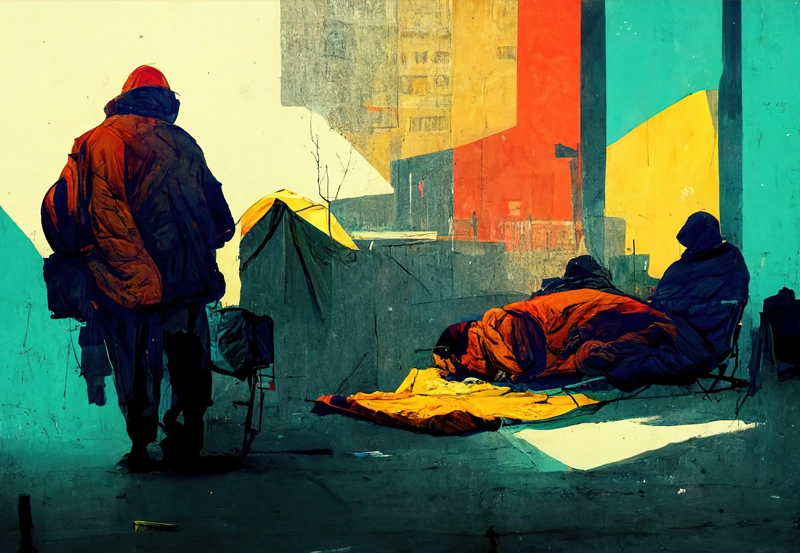Search
Criminalization Will Not Solve Homelessness—Housing Will
October 28, 2025

Homelessness is not inevitable—it is the direct result of a chronic shortage of affordable housing. For decades, our nation has chosen to prioritize market-rate development while underinvesting in homes for families of modest means. Today, more than 771,000 people in the United States experience homelessness, the highest number since data collection began. Bay Area families know the crisis firsthand: thousands are spending more than 30% of their income on rent, pushing them to the edge of instability.
Yet instead of advancing proven solutions, recent federal and state actions double down on failed approaches—criminalizing people for being unhoused, undermining Housing First, and stripping away life-saving services.
How We Got Here
The July 24 Executive Order, Ending Crime and Disorder on America’s Streets, expands law enforcement and forced institutionalization, rewards states that criminalize homelessness, and cuts off harm-reduction services. This action follows last year’s Grants Pass v. Johnson Supreme Court ruling, which gave local governments greater authority to penalize people for sleeping outside even when shelter is unavailable.
California, long known for compassion toward people experiencing homelessness, supported that ruling. The Governor argued that local jurisdictions should have the authority to enforce anti-camping measures, and subsequent legislation reflected that shift. SB 634, once introduced to prohibit criminal penalties against unhoused residents, was amended to only protect service providers from punishment. While billions have been invested in emergency services, much less has gone into affordable housing and prevention strategies that would stop homelessness before it begins. SB 634 has passed and is now on the Governor’s desk.
None of these actions reduce housing costs. None prevents families from eviction. Instead, this approach redirects taxpayer money from real solutions and ensures more people will end up living in tents, cars, or on the streets.
Why Criminalization Fails
History and data show that criminalization does not reduce homelessness.
Across the Bay Area, we see the impact of ordinances that punish survival. Fremont, San Jose, and Redwood City have all advanced broad encampment bans and anti-camping measures. These policies add fines and criminal records that make it harder to find employment and housing, while consuming scarce public dollars on policing and court costs. They do not reduce homelessness—they deepen it.
The safest communities are not those that criminalize poverty. They are the ones that invest in housing, health care, and support networks. Forced treatment and punitive measures are not only ineffective but also unethical and, in many cases, unlawful. Criminalization sees homelessness as an individual failing; a nuisance to be hidden instead of a systemic crisis to be addressed.
What Works: Housing First with Services
There are better models. In some jurisdictions, ordinances require outreach and service offers before encampments are cleared, prohibit sweeps unless adequate shelter or housing is available, and invest in sanctioned safe-parking or transitional housing tied directly to permanent housing placements. These approaches align with Housing First principles. They reduce harm, safeguard rights, and open pathways to stability rather than closing doors.
Housing First remains one of the most studied and successful interventions in addressing homelessness. When people are provided with safe, affordable homes and voluntary supportive services, they stay housed long-term. Cities that adopt this model see declines in chronic homelessness, stronger health outcomes, and healthier communities overall.
Supportive services, such as case management, mental health care, and job training, are not optional add-ons; they are the tools that help people maintain housing stability and rebuild their lives. Housing First does not ask people to prove they are “ready” for housing; it starts with the recognition that a safe, stable home is the foundation for any other progress.
A Better Path Forward
At United Way Bay Area, we believe that solving homelessness requires dignity, prevention, and housing – not punishment. That means building more affordable homes, so families don’t have to choose between rent and food. It means enacting strong tenant protections, so residents aren’t displaced by sudden rent hikes or unfair evictions. And it means funding supportive services that help people remain stably housed, regardless of the challenges they face.
We also know this work cannot be done alone. Solving homelessness requires a coalition: advocates, service providers, community members, and policymakers working together to find solutions that restore dignity and stability. It means lifting the needs and experiences of the people living through the crisis every day until those solutions are made affordable realities.
How, you ask? Here are some ways we can channel our energies together into meaningful action:
- Advocate for legislation that supports evidence-based solutions at the state level, such as SB 634, and at the local level through our Boards of Supervisors and city councils.
- Attend educational events to learn more about solutions to homelessness, such as the National Alliance to End Homelessness’ virtual Hill Day.
- Join local and regional coalitions to collaborate with others, advance solutions, and learn from fellow advocates, such as For Every Neighbor https://foreveryneighbor.org/
We are committed to building those coalitions, advancing evidence-based legislation, and holding systems accountable for real results.
Criminalization only pushes people further to the margins. Housing is the answer – first, and always.


